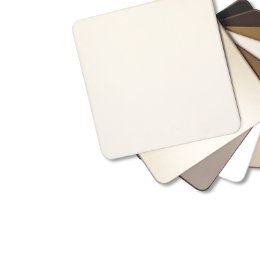Understanding Visual Acceptance Standards for Architectural Panels

What you need to know to ensure the integrity of your architectural design
Architects and project owners generally have a good understanding of structural, fire, electrical and other building standards – and can easily agree on whether an item is or is not in compliance. That’s because the industry standards can be expressed in terms of objective criteria, which are thoroughly documented in applicable building codes.
When it comes to standards for visual acceptability, sometimes understanding and agreement don’t come as easily. Who’s to say, for example, whether a tiny imperfection in an installed architectural panel falls within an acceptable range of variability? If the building owner believes a barely perceptible dent warrants replacement of a panel, and the architect believes it’s normal and acceptable under industry norms, who’s right? Isn’t it all subjective?
These judgments can indeed be subjective to a point, but that’s all the more reason industry standards are necessary to avoid disagreement and to adjudicate disagreements when they do arise. Industry standards for visual acceptability have in fact been developed – and in many cases have been formalized in building codes – although many are unaware these standards are in place.
The Metals Construction Association has recently published a white paper detailing visual acceptance standards for metal composite materials (MCM) used for architectural cladding. We recommend downloading the paper for a thorough review. Here’s a brief summary of the issues involved.
Panel Deflection
Panels tend to deflect from a flat plane either due to wind loading or thermal expansion and contraction. In the case of wind loading, specific deflection limits of various structural building components are defined in the International Building Code. For non-structural MCM cladding, the allowable deflection center of panel is L/60.
In this formulation, “L” represents the longest dimensional length of the panel in inches. So, for example, a five-foot long panel would be allowed to deflect up to one inch (60″/60) under severe wind loading. This limit is based on the ability of MCM cladding to deflect significantly and spring back to its original shape without yielding.
IBC also provides a specification for perimeter aluminum frame deflection. Although this standard is primarily intended to limit movement of structural members that support glass, MCA also regards this as a best-practice standard for MCM panel perimeter framing. Panel systems should be designed to support a perimeter framing deflection limit of L/175.
Panel Bow
While the term “panel deflection” is used to describe temporary movement due to wind loading, “panel bow” refers to dimensional changes due to temperature variations. If panels are installed in a way that constrains their movement, dimensional changes can cause panels to bow as the temperature rises substantially above the prevailing temperature at installation.
Panel bow is generally temporary, subsiding as the temperature falls again. MCA provides several recommendations for diminishing or eliminating panel bow. Examples include installing panels under conditions consistent with average local temperatures, using slotted holes to attach panels to framing members, using flexible adhesives, and installing panels with a fixed point in the center of the panel while allowing for freedom of movement at the edges.
Using these techniques and others, MCA believes careful design and planning can avoid most panel bow issues. If problems do arise, the MCA recommendations can provide a basis for investigating and addressing the root cause.
Surface Imperfections
Evaluating dents, dimples and other visible surface defects can be quite subjective. An imperfection that few people would ever notice without close inspection may be judged as unacceptable by a particularly demanding building owner. Complicating matters is the fact that building codes make no mention of standards for visual acceptability of minor surface imperfections.
Several voluntary industry standards do exist, however. In particular, MCA recommends adopting a standard for MCM panels in line with recommendations from both the Insulated Glass Manufacturers Association and the American Architectural Manufacturers Association.
Both these organizations describe a visual inspection procedure that involves standing 10 feet away and inspecting for imperfections while looking at the building surface at a perpendicular (90°) angle under natural exterior lighting conditions. This procedure avoids the exaggeration of normal surface variations due to an overly acute inspection or lighting angle.
If an observer can look straight-on at the building from 10 feet away under normal lighting conditions (not under the glancing light that might be encountered at sunrise or sunset, for example) and not see surface imperfections, the building panel is considered to be within normal manufacturing specifications. If imperfections can be seen under these conditions and the project owner deems them unacceptable, there may be grounds to request remediation or panel replacement.
Finish Performance and Color-Fastness
Building codes do not address finish colors and performance, although these are normally detailed in project specifications. These specifications often rely on ASTM, AAMA and/or NCCA standards for resistance to impacts, wear, corrosion and other performance criteria.
The visual appearance of colors can vary for a variety of reasons, including lot-to-lot color variations, grain directionality of metallic- or mica-based coatings, degradation of colors due to sun exposure and weathering, cleaning procedures and several other issues.
Due to the wide range of available panel finishes and performance variability due to color choice, application, geography, sun exposure and other factors, color performance should be specified in the warranty for the specific project. In general 5 dE units of color change over the life of the warranty is considered to be acceptable (1 dE unit is defined as a minimally perceptible color difference).
Several other color performance issues are covered in the International Building Code and other industry resources. We recommend consulting MCA’s white paper, linked below, for a complete discussion of the applicable standards.
Learn more
Download the MCA white paper, Visual Acceptance Parameters for Metal Composite Material (MCM) Panels and Panel Systems for complete information on industry standards that can help you avoid visual anomalies in your building projects – and help you deal affirmatively with any questions that may arise during construction or after the project has been completed.






